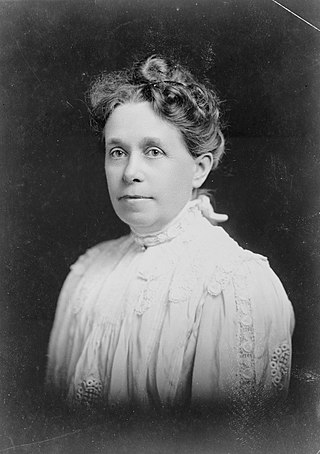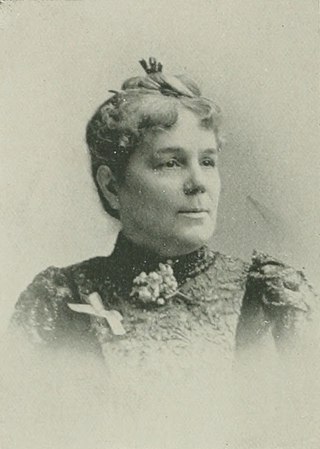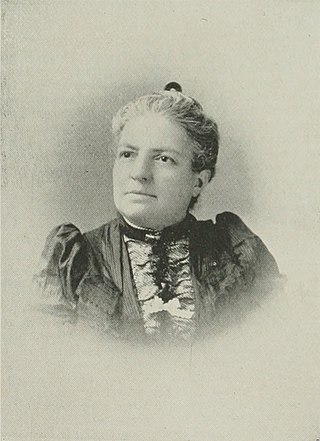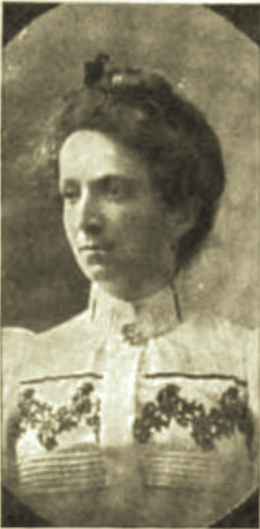The Woman's Christian Temperance Union (WCTU) is an international temperance organization. It was among the first organizations of women devoted to social reform with a program that "linked the religious and the secular through concerted and far-reaching reform strategies based on applied Christianity." It plays an influential role in the temperance movement. Originating among women in the United States Prohibition movement, the organization supported the 18th Amendment and was also influential in social reform issues that came to prominence in the progressive era.

Frances Elizabeth Caroline Willard was an American educator, temperance reformer, and women's suffragist. Willard became the national president of Woman's Christian Temperance Union (WCTU) in 1879 and remained president until her death in 1898. Her influence continued in the next decades, as the Eighteenth and Nineteenth Amendments to the United States Constitution were adopted. Willard developed the slogan "Do Everything" for the WCTU and encouraged members to engage in a broad array of social reforms by lobbying, petitioning, preaching, publishing, and education. During her lifetime, Willard succeeded in raising the age of consent in many states as well as passing labor reforms including the eight-hour work day. Her vision also encompassed prison reform, scientific temperance instruction, Christian socialism, and the global expansion of women's rights.

Anna Adams Gordon (1853–1931) was an American social reformer, songwriter, and, as national president of the Woman's Christian Temperance Union when the Eighteenth Amendment was adopted, a major figure in the Temperance movement.

Mary Greenleaf Leavitt was an educator and successful orator who became the first round-the-world missionary for the Woman's Christian Temperance Union (WCTU). Setting out on virtually non-stop worldwide tours over a decade, she "went to all continents save Antarctica," where she crusaded against alcohol and its evils including domestic violence; and advocated for women's suffrage and other equal rights such as higher education for women. In 1891 she became the honorary life president of the World's WCTU.
The Woman's Temperance Publishing Association (WTPA) was a non-commercial publisher of temperance literature. Established in 1879 in Indianapolis, Indiana during the national convention of the Woman's Christian Temperance Union (WCTU), it was a concept of Matilda Carse, an Irish-born American businesswoman, social reformer and leader of the temperance movement.

The Woman's Christian Temperance Union Administration Building is a historic building in Evanston, Illinois, United States. It has served as the publishing house and national headquarters of the Woman's Christian Temperance Union since its construction in 1910. The organization had an important role in the national discussion on prohibition and women's suffrage.

Mary H. Bannister Willard was an American editor, temperance worker, and educator from the U.S. state of New York. She was the founder of the American Home School for Girls in Berlin, Germany, earlier having served as editor of the Post and Mail and The Union Signal.

Mary Towne Burt was a 19th-century American temperance reformer, newspaper publisher, and benefactor from Ohio. Burt was identified with temperance work nearly all her life. She was the first president of the Auburn, New York branch of the Women's Christian Temperance Union, and beginning in 1882, served as president of the New York State Society of the Union. In 1875, she became the publisher, and subsequently the editor, of Our Union, the organ of the society, and in 1878–80 was the corresponding secretary of the National Union. For several years, Burt had charge of the legislative interests of the union, and several laws for the protection of women and young girls resulted from her efforts.

Esther Pugh was an American temperance reformer of the long nineteenth century. She served as Treasurer of the National Woman's Christian Temperance Union (WCTU), a Trustee of Earlham College, as well as editor and publisher of the monthly temperance journal, Our Union.

Mary Allen West was an American journalist, editor, educator, philanthropist, superintendent of schools, and temperance worker. A teacher in her early career, she served as superintendent of schools in Knox County, Illinois, being one of the first women to fill such a position in Illinois. An active supporter of the temperance movement, West served as president of the Illinois Woman's Christian Temperance Union (WCTU), and editor of the national paper, Union Signal. Her other roles within the WCTU included superintendent of the Training School for Temperance Workers, Illinois State Superintendent of Temperance in Schools of Higher Education, as well as Stockholder, Director, and Secretary of the Woman's Publication Association. She was the first president of the Illinois Woman's Press Association, a member of the Chicago Woman's Club, and director of the Protective Agency for Women and Children. West was the author of Childhood: Its Care and Culture (1887). She died in Japan, in 1892, while training temperance workers in organization and promotion reform efforts.

Jennie Fowler Willing was a Canadian-born American educator, author, preacher, social reformer, and suffragist. She married a lawyer and Methodist pastor at age 19. In 1873, she and her husband became professors at Illinois Wesleyan University. In addition to teaching, she was a leader in the temperance movement. Willing came to notice when she joined the Illinois Woman's State Temperance Union, serving as its leader for some years. She and Emily Huntington Miller were involved with creating and presiding over the First Woman's National Temperance Convention of 1874 in Cleveland where the National Woman's Christian Temperance Union was formed. She served as the editor of the national organization's journal for a period. In 1895, she created the New York Evangelistic Training School. Willing wrote several books including From Fifteen to Twenty-five: A Book for Young Men and serials for newspapers.

Caroline Brown Buell was an American activist who lectured and wrote on behalf of temperance and suffrage. She served as the assistant recording secretary (1878–80), corresponding secretary (1880–93), and a member of the Our Union publication committee (1876–83) of the National Woman's Christian Temperance Union (WCTU); as well as the president (1904) and corresponding secretary (1875–86) of the Connecticut WCTU. She also originated the plan of the Loyal Temperance Legion, the children's society of the WCTU. Buell wrote extensively for temperance publications, and other papers and magazines. She made her home in East Hampton, Connecticut.
Margaret E. Winslow (1836-1936) was an American activist, newspaper editor, and author of several temperance books. She served at two separate times, and during the longest period of any editor-in-chief of Our Union, the national organ of the Woman's Christian Temperance Union (WCTU). It was a burst of inspiration from Winslow, relative to its simplicity and purity, which at the National WCTU Convention in Chicago determined the union to wear the white ribbon as a badge rather than the red, white, and blue which was strongly urged by many.

Esther T. Housh was a 19th-century American social reformer, author, and newspaper editor. She was the President of the Vermont State Woman's Christian Temperance Union (WCTU). While serving as press superintendent of the National WCTU, she instituted the National Bulletin. She was the editor of The Woman's Magazine, as well as the author of many temperance leaflets, and poems.
The First Woman's National Temperance Convention was a founding event in the establishment of the American Woman's Christian Temperance Union (WCTU).

Mary Osburn Adkinson was an American social reformer active in the temperance movement. She took a leading part in the organization of the Woman's Foreign Missionary Society of the Methodist Episcopal Church in Madison, Wisconsin, serving four times as its elected president. In Louisiana, she held the position of superintendent of the Woman's Christian Temperance Union (WCTU) and matron in the New Orleans University.

Temperance Temple served as the headquarters of the National Woman's Christian Temperance Union (WCTU). It was located in Chicago, Illinois at the southwest corner of LaSalle Street and Monroe Street, in the center of city's financial district. Work was begun in July, 1890, and the building was ready for occupancy in May 1892. The lot was valued at US$1,000,000; the rentals from the building were expected to bring in an annual income of over US$200,000. The capital stock was US$600,000, one-half of which was owned by the Temple Building Association of Chicago (TBAC), and it was expected all would be secured to that association. The TBAC, a stock company with Marshall Field president of the board of trustees, owned The Temple, the third of the affiliated interests of the National WCTU. The office building was erected at a cost of US$1,200,000 on ground leased to the TBAC by Field. Temperance Temple was demolished in 1926.

Jane Agnes Stewart was an American author, editor, and contributor to periodicals. She was a special writer for many journals on subjects related to woman's, religious, educational, sociological, and reform movements. Stewart was a suffragist and temperance activist. She traveled to London, Edinburgh, and Paris as a delegate of world's reform and religious conventions.
The Second Annual Meeting of the National Woman's Christian Temperance Union (N.W.C.T.U.) was held in St. Paul's Methodist Episcopal church, Cincinnati, Ohio, November 17-19, 1875.
The Third Annual Meeting of the National Woman's Christian Temperance Union (N.W.C.T.U.) was held in Newark, New Jersey, October 25-28, 1876. Twenty-two State unions were represented at this meeting, and local unions were reported as having been formed for the first time in Tennessee, Louisiana, and Arkansas, preparatory to State organizations. No officer of the N.W.C.T.U. received a dollar for services or traveling expenses during the year. Robert's Rules of Order was adopted as the parliamentary authority for the N.W.C.T.U.
















